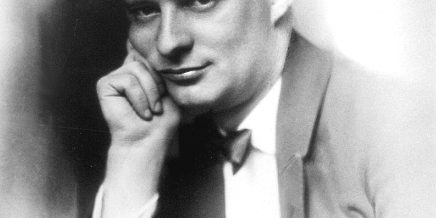
Paul Hindemith in 1923, shortly after composing the original version of Das Marienleben

Rainer Maria Rilke, painted by Leonid Pasternak
By Kameron Ghanavati
Student collaborators Sara DeFranco, Keely Futterer, Hannah Harrow, and Sarah Korath, alongside Assistant Professor of Accompanying Beryl (Berri) Garver, are teaming up for a unique concert in Hatch Recital Hall tomorrow night (see details below). Using multimedia outlets complete with images and translations, Medieval apocryphal text, and a perennial story focused on the Virgin Mary, the group will present Paul Hindemith’s moving song cycle Das Marienleben (The Life of Mary), focusing on the life and death of Mary and her unique journey. Hindemith set the music to Rainer Maria Rilke’s stunning poems, which were originally paired with paintings by Heinrich Vogeler. The piece is being performed as part of the Faculty Artist Series and is generously supported by Patricia Ward-Baker.
“It’s very human,” comments Berri, who began planning the work many months ago. “[Hindemith’s] approach to dissonance is different,” comments second-year graduate student Hannah Harrow. “It did not grab me at first…but after singing it for a few months I find I’m really enjoying it.”
Hannah further explained to me the challenges of this piece and how often she practices just to retain it. The harmonies often bleed through phrases to create an impressionist image of Mary’s inner thoughts and outward experiences. Often, the vocal line is juxtaposed with the piano part and creates a beautifully intense sensation for the listener, sprinkled with Hindemith’s repeating thematic ideas. Certainly not a piece of music to be missed!
Seeing that the 70-minute composition, written for solo soprano, would be daunting for young students, Berri split the fifteen songs of Das Marienleben into four parts and selected students of varying ages to represent Mary at different stages throughout her life. It works magnificently well, creating a more dramatic effect and allowing the performers to hone a particular segment of Mary’s life.

An image by Heinrich Vogeler from his illustrations for Rilke’s Das Marienleben
The use of multimedia within this presentation adds authenticity and seems only fitting, seeing that the original intent of the poems were influenced by Vogeler’s paintings. The imagery presented will surely help guide the audience and create more stimulus for the senses. Berri has created an audience-friendly experience by inserting an intermission, something not originally programmed when Hindemith composed the piece.
Together, these elements are combined to create a refined finish to a timeless piece. As audience expectations change with societal influences, it is vital that artists begin to think of unique ways to flavor a particular piece while maintaining its original intent. Hindemith himself did so after the premiere of Das Marienleben in 1922, revising the piece extensively in the 1930s and 1940s. An interesting point to be noted about the aforementioned musical setting: Das Marienleben succumbed to the composer’s artistic strife following its critically acclaimed premier. Hindemith revised the piece in a more cyclical style, with repeated themes and a setting that served the poetry better and stimulated recollection from the audience, which helps to establish their personal relationship with the piece as they experience it.
This particular arrangement of Das Marienleben certainly brings a unique twist to a timeless story. I commend Berri for programming such a unique and vivid presentation of this wonderfully difficult piece. You certainly won’t want to miss it.
Hindemith: Das Marienleben (The Life of Mary)
Thursday, October 13 at 8 p.m.
Hatch Recital Hall
All seats $10, free for University of Rochester ID holders

